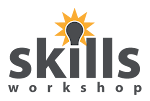Had a lovely 2 hour Entry Level (E1 through to E3) Functional Maths and English lesson earlier this week, based on the royal wedding. Objectives were to encourage the use of accurate positional vocabulary and to improve the use of clear (written and spoken) directions.
I hadn't met the group before (but they all knew each other well) so came up with the following starter to help me to remember all their names and help them improve their use of positional vocabulary.
I asked one student to introduce himself clearly and to then tell me where he was sitting in relation to another student. (I modelled this to the group first, using the rather advanced example of diagonally opposite which provoked quite a lot of discussion.)
So, for example, the student might say: "I'm Kamil."
Then, I would say: "Hello Kamil. Tell me where you are in relation to another person in the group."
Kamil might then say: "I'm sitting next to Mona."
Mona would then introduce herself (the repetition of her name helping me to remember it) and then describe her position in relation to to another student in the room.
...and so on round the entire group.
 |
| Wordle 1. Individual positional words used by students. |
Whilst this was going on my LSA was typing all the positional words each student used into Wordle (he also copied and pasted them into a Word document for future use). When everyone had introduced themselves the create button was clicked and Wordle 1 appeared.
At that time I couldn't remember how to keep words together as phrases so Wordle 1 shows you all the individual positional words the students used.
Later, I remembered that to keep words together in Wordle you use a tilde ~ between related words. I edited the saved Word document accordingly and the resulting Wordle 2 shows the exact phrases students used.
Sounds simple but the students were enthralled with the Wordle. I've told them that I plan to repeat this activity several sessions later to check their learning and see if they are using a greater range of positional vocabulary. I particularly want to improve the accurate use of left and right in written and spoken directions.
I also successfully recited all their names (they insisted on testing me!) - no mean feat as my memory is terrible at the moment.
 |
| Wordle 2. Using tilde symbols to keep words together in phrases. |
If you like our Wordle design, we used: League Gothic font, a mostly horizontal layout with straighter edges and the organic carrot colour scheme!
In case you're wondering what all this has to do with the royal wedding: I used it as a lead in to watching two videos about the wedding route. Whilst watching these, students were asked to look out for and list famous London landmarks and we discussed how you can use landmarks to help clarify written or spoken directions.
Video 1: Royal wedding route in 40 seconds
Video 2: Google maps Royal wedding procession route in 3D
Landmarks spotted included Buckingham Palace, the London Eye and the Cenotaph (interesting spelling discussion on that one!).
I embedded the videos into the end of a very good Royal Wedding PPT I obtained from TES resources. At the start of the PPT all students were asked to write one correctly punctuated sentence about the royal wedding (on individual whiteboards). As a learning check, at the close of the PPT, they were asked to write two sentences about something new they had found out about the upcoming wedding. (More interesting discussion about Kate's head-ware in slide 2! I just couldn't remember the word "fascinator" but a savvy student put me right!)
 |
| Adapted from a TES resource - see main text for details. |
This was followed by paired work: drawing routes to various destinations (canteen, library, reception, etc.) on a college map and then following their planned route around the college and writing accompanying directions. The writing frame we used was adapted from this one on skillsworkshop.org.
I also embedded a Google satellite map of the college into the PPT. This was a huge hit and great for students to annotate on the Smartboard. I will be making future use of this map when we do work on 2D and 3D shapes
In my next session - before I embark on my still unplanned simulation of the AV voting system - I will hand out anonymous typed-up-by-me copies of the directions written by the students (with the name of the destination omitted) to different pairs of students to test.
Functional Skills coverage and range statements covered in the session included:
Maths
Describe position (E1)
Extract, use & compare information from lists, tables, simple charts /graphs (E3)
Recognise and use 2D representations of 3D objects (L2)
Speaking, listening and communication
Communicate information so that the meaning is clear (E2)
Identify the main points of short explanations and instructions (E2)
Reading
Read and understand simple instructions and directions (E2)
Use organisational features to locate information (E3)
Writing
Use written words and phrases to present (and record) information. E1 (E2)
Construct simple (compound) sentences using full stops (correct upper/lower case). E1 (E2)
Sequence writing logically and clearly. (E3)





1 comment:
Very nice and informative blog and it will help the people in communications with each other.Thanks for sharing that stuff.
www.keemat.pk
Post a Comment